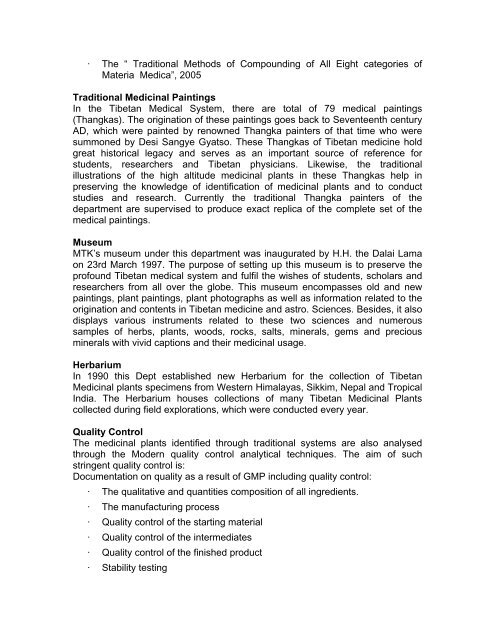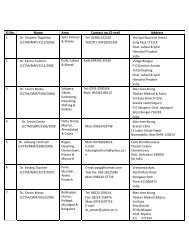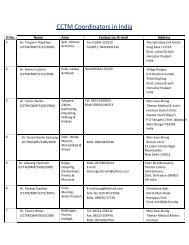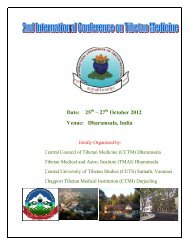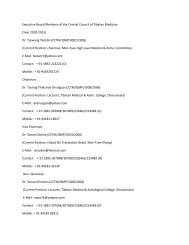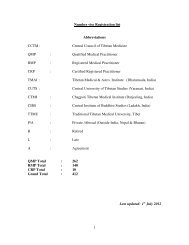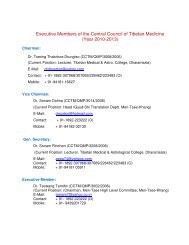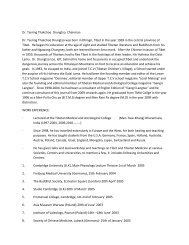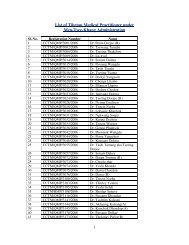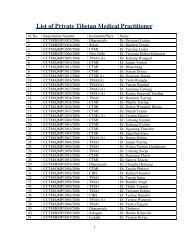1. The Central Council of Tibetan Medicine (CCTM) The Central ...
1. The Central Council of Tibetan Medicine (CCTM) The Central ...
1. The Central Council of Tibetan Medicine (CCTM) The Central ...
You also want an ePaper? Increase the reach of your titles
YUMPU automatically turns print PDFs into web optimized ePapers that Google loves.
· <strong>The</strong> “ Traditional Methods <strong>of</strong> Compounding <strong>of</strong> All Eight categories <strong>of</strong><br />
Materia Medica”, 2005<br />
Traditional Medicinal Paintings<br />
In the <strong>Tibetan</strong> Medical System, there are total <strong>of</strong> 79 medical paintings<br />
(Thangkas). <strong>The</strong> origination <strong>of</strong> these paintings goes back to Seventeenth century<br />
AD, which were painted by renowned Thangka painters <strong>of</strong> that time who were<br />
summoned by Desi Sangye Gyatso. <strong>The</strong>se Thangkas <strong>of</strong> <strong>Tibetan</strong> medicine hold<br />
great historical legacy and serves as an important source <strong>of</strong> reference for<br />
students, researchers and <strong>Tibetan</strong> physicians. Likewise, the traditional<br />
illustrations <strong>of</strong> the high altitude medicinal plants in these Thangkas help in<br />
preserving the knowledge <strong>of</strong> identification <strong>of</strong> medicinal plants and to conduct<br />
studies and research. Currently the traditional Thangka painters <strong>of</strong> the<br />
department are supervised to produce exact replica <strong>of</strong> the complete set <strong>of</strong> the<br />
medical paintings.<br />
Museum<br />
MTK’s museum under this department was inaugurated by H.H. the Dalai Lama<br />
on 23rd March 1997. <strong>The</strong> purpose <strong>of</strong> setting up this museum is to preserve the<br />
pr<strong>of</strong>ound <strong>Tibetan</strong> medical system and fulfil the wishes <strong>of</strong> students, scholars and<br />
researchers from all over the globe. This museum encompasses old and new<br />
paintings, plant paintings, plant photographs as well as information related to the<br />
origination and contents in <strong>Tibetan</strong> medicine and astro. Sciences. Besides, it also<br />
displays various instruments related to these two sciences and numerous<br />
samples <strong>of</strong> herbs, plants, woods, rocks, salts, minerals, gems and precious<br />
minerals with vivid captions and their medicinal usage.<br />
Herbarium<br />
In 1990 this Dept established new Herbarium for the collection <strong>of</strong> <strong>Tibetan</strong><br />
Medicinal plants specimens from Western Himalayas, Sikkim, Nepal and Tropical<br />
India. <strong>The</strong> Herbarium houses collections <strong>of</strong> many <strong>Tibetan</strong> Medicinal Plants<br />
collected during field explorations, which were conducted every year.<br />
Quality Control<br />
<strong>The</strong> medicinal plants identified through traditional systems are also analysed<br />
through the Modern quality control analytical techniques. <strong>The</strong> aim <strong>of</strong> such<br />
stringent quality control is:<br />
Documentation on quality as a result <strong>of</strong> GMP including quality control:<br />
· <strong>The</strong> qualitative and quantities composition <strong>of</strong> all ingredients.<br />
· <strong>The</strong> manufacturing process<br />
· Quality control <strong>of</strong> the starting material<br />
· Quality control <strong>of</strong> the intermediates<br />
· Quality control <strong>of</strong> the finished product<br />
· Stability testing


